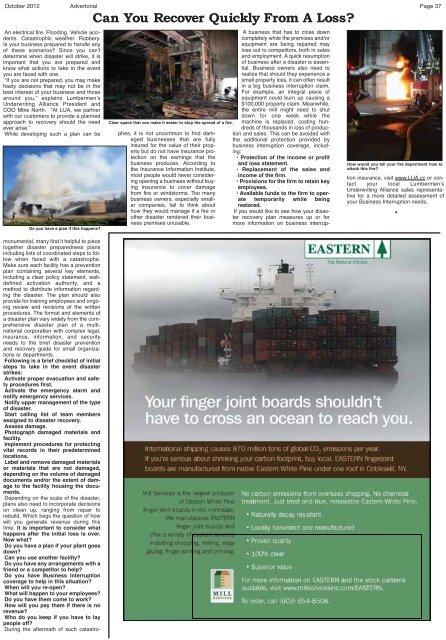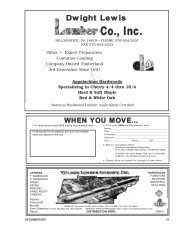Part 2 - Miller Publishing Corporation
Part 2 - Miller Publishing Corporation
Part 2 - Miller Publishing Corporation
You also want an ePaper? Increase the reach of your titles
YUMPU automatically turns print PDFs into web optimized ePapers that Google loves.
October 2012 Advertorial Page 37An electrical fire. Flooding. Vehicle accidents.Catastrophic weather. Robbery.Is your business prepared to handle anyof these scenarios? Since you canʼtdetermine when disaster will strike, it isimportant that you are prepared andknow what actions to take in the eventyou are faced with one.“If you are not prepared, you may makehasty decisions that may not be in thebest interest of your business and thosearound you,” explains LumbermenʼsUnderwriting Alliance President andCOO Mike North. “At LUA, we partnerwith our customers to provide a plannedapproach to recovery should the needever arise.”While developing such a plan can beDallas,Texas—Do you have a plan if this happens?monumental, many find it helpful to piecetogether disaster preparedness plansincluding lists of coordinated steps to followwhen faced with a catastrophe.Make sure each facility has a preventionplan containing several key elements,including a clear policy statement, welldefinedactivation authority, and amethod to distribute information regardingthe disaster. The plan should alsoprovide for training employees and ongoingreview and revisions of the writtenprocedures. The format and elements ofa disaster plan vary widely from the comprehensivedisaster plan of a multinationalcorporation with complex legal,insurance, information, and securityneeds to the brief disaster preventionand recovery guide for small organizationsor departments.Following is a brief checklist of initialsteps to take in the event disasterstrikes:Activate proper evacuation and safetyprocedures first.Activate the emergency alarm andnotify emergency services.Notify upper management of the typeof disaster.Start calling list of team membersassigned to disaster recovery.Assess damage.Photograph damaged materials andfacility.Implement procedures for protectingvital records in their predeterminedlocations.Label and remove damaged materialsor materials that are not damaged,depending on the volume of damageddocuments and/or the extent of damageto the facility housing the documents.Depending on the scale of the disaster,plans also need to incorporate decisionson clean up, ranging from repair torebuild. Which begs the question of howwill you generate revenue during thistime. It is important to consider whathappens after the initial loss is over.Now what?Do you have a plan if your plant goesdown?Can you use another facility?Do you have any arrangements with afriend or a competitor to help?Do you have Business Interruptioncoverage to help in this situation?When will you re-open?What will happen to your employees?Do you have them come to work?How will you pay them if there is norevenue?Who do you keep if you have to laypeople off?During the aftermath of such catastro-Can You Recover Quickly From A Loss?Clear space that can make it easier to stop the spread of a fire.phes, it is not uncommon to find damagedbusinesses that are fullyinsured for the value of their propertybut do not have insurance protectionon the earnings that thebusiness produces. According tothe Insurance Information Institute,most people would never consideringopening a business without buyinginsurance to cover damagefrom fire or windstorms. Too manybusiness owners, especially smallercompanies, fail to think abouthow they would manage if a fire orother disaster rendered their businesspremises unusable.A business that has to close downcompletely while the premises and/orequipment are being repaired maylose out to competitors, both in salesand employment. A quick resumptionof business after a disaster is essential.Business owners also need torealize that should they experience asmall property loss, it can often resultin a big business interruption claim.For example, an integral piece ofequipment could burn up causing a$100,000 property claim. Meanwhile,the entire mill might need to shutdown for one week while themachine is replaced, costing hundredsof thousands in loss of productionand sales. This can be avoided withthe additional protection provided bybusiness interruption coverage, including:• Protection of the income or profitand loss statement.• Replacement of the sales andincome of the firm.• Provisions for the firm to retain keyemployees.• Available funds to the firm to operatetemporarily while beingrestored.If you would like to see how your disasterrecovery plan measures up or formore information on business interrup-How would you tell your fire department how toattack this fire?tion insurance, visit www.LUA.cc or contactyour local LumbermenʼsUnderwriting Alliance sales representativefor a more detailed assessment ofyour Business Interruption needs.•
















